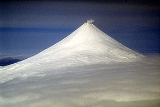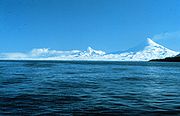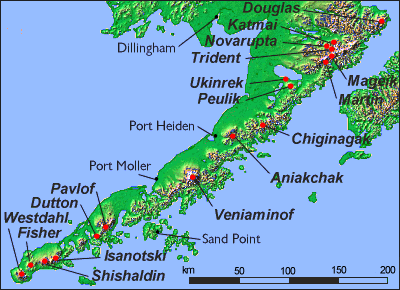
Mount Shishaldin
Encyclopedia


Volcano
2. Bedrock3. Conduit 4. Base5. Sill6. Dike7. Layers of ash emitted by the volcano8. Flank| 9. Layers of lava emitted by the volcano10. Throat11. Parasitic cone12. Lava flow13. Vent14. Crater15...
on Unimak Island
Unimak Island
Unimak Island is the largest island in the Aleutian Islands chain of the U.S. state of Alaska. It is the easternmost island in the Aleutians and, with an area of 1,571.41 mi² , the ninth largest island in the United States and the 134th largest island in the world. It is home to Mount...
in the Aleutian Islands chain of Alaska
Alaska
Alaska is the largest state in the United States by area. It is situated in the northwest extremity of the North American continent, with Canada to the east, the Arctic Ocean to the north, and the Pacific Ocean to the west and south, with Russia further west across the Bering Strait...
. It is the tallest mountain in the Aleutian Islands. The most symmetrical cone-shaped glacier-clad large mountain on earth, the volcano's topographic contour lines are nearly perfect circles above 6500 feet (1,981.2 m). The lower north and south slopes are somewhat steeper than the lower eastern and western slopes. The volcano is the westernmost of three large stratovolcanoes along an east–west line in the eastern half of Unimak Island. The Aleuts named the volcano Sisquk, meaning "mountain which points the way when I am lost." The upper 2,000 meters is almost entirely covered by glacial snow and ice. In all, Shishaldin's glacial shield cover about 35 square miles (90.6 km²). It is flanked to the northwest by 24 monogenetic parasitic cones, an area blanketed by massive a lava flows. The Shishaldin cone is less than 10,000 years old and is constructed on a glacially eroded remnant of an ancestral soma and shield. Remnants of the older ancestral volcano are exposed on the west and northeast sides at 1,500–1,800 meters elevation. The Shishaldin edifice contains about 300 cubic kilometers of material. A very steady steam plume rises from its small summit crater which is about 500 feet (152.4 m) across and slightly breached along the north rim.
Activity
This volcano has had many recorded eruptions during the 19th and 20th centuries, and a couple reports of volcanic activity in the area during the 18th century may have referred to Shishaldin as well. Therefore the volcano's entire recorded history is spotted with reports of activity.Mount Shishaldin's most recent eruptions were in 1995–96 and 1999. Since the 1999 eruption, it has maintained seismic activity, typically having very low-magnitude volcanic earthquakes (most are below magnitude 1) every 1–2 minutes. During this period of non-eruptive seismic activity, it has been puffing steam, with puffs also occurring about every 1–2 minutes. There were reports in 2004 of small quantities of ash being emitted with the steam.
The Alaska Volcano Observatory monitors the volcano for more hazardous activity with seismometers and satellite images. Visual observations are rare, because of the remote location of the volcano.
Climbing
The first recorded ascent of Shishaldin was in 1932, by G. Peterson and two companions. Given the straightforward nature of the climbing (Alaska Grade 1, snow up to 40 degree slope), it is possible that an earlier ascent occurred, either by native Aleuts, Russians, or other visitors. Shishaldin is a popular ski descent (6,000 feet/1,830 m vertical) for local climbers (of whom there are few). Due to its remoteness Shishaldin is not often climbed by outsiders.Sources
- Peterson, T., J. Caplan-Auerbach, and S. McNutt. Sustained Long-period Seismicity at Shishaldin Volcano, Alaska. Journal of Volcanology and Geothermal Research, Volume 151, Issue 4, 15 March 2006, pages 365-381. Available online http://www.sciencedirect.com/science?_ob=ArticleURL&_udi=B6VCS-4HM7RY6-1&_coverDate=03%2F15%2F2006&_alid=382010644&_rdoc=1&_fmt=&_orig=search&_qd=1&_cdi=5962&_sort=d&view=c&_acct=C000050221&_version=1&_urlVersion=0&_userid=10&md5=6c451b785fad5142f15c4017550e52e4.
- Volcanoes of the Alaska Peninsula and Aleutian Islands-Selected Photographs
- Alaska Volcano Observatory (Shishaldin webcam)
- Michael Wood and Colby Coombs, Alaska: a climbing guide, The Mountaineers, 2001.

